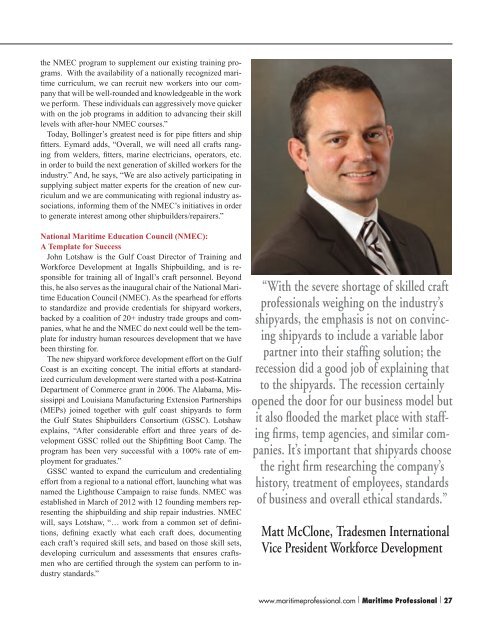TRAINING & RECRUITMENTWeeks Marine, Inc.PORT ENGINNERSJR PORT ENGINNERSwww.weeksmarine.compecov@weeksmarine.com985-875-2575Tradesmen: National Coverage &a Skilled, Diverse WorkforceAccording to Matt McClone, Tradesmen International VicePresident Workforce Development, the key advantages of engagingTradesmen as a staffing partner is rooted in their abilityto meet the distinct trade requirements of shipyards, beginningwith their national team of shipyard coordinators: formermariners, merchant captains, shipbuilding professionals, navalofficers, and enlisted men. “With these insights, they havethe unique ability to understand the unique and dynamic needsof the shipyard industry. That, along with our national reachincluding a permanent presence in 36 port cities allows us toaccess a very large pool of skilled marine craftsmen and provideuniform service in all shipyard locations.”Tradesmen International’s screening process is stringent: aminimum of two interviews; skill-testing using MOCode testsand available hands-on testing; verification of a minimumthree years of experience; reference checks with a minimumof three employers; background checks that meet client standards;drug testing as required by the client; E-Verification toprove U.S. Citizenship; a valid driver’s license and reliabletransportation verification and confirmation of PPE and appropriatetools-of-the trade ownership. Not just anyone gets towork under the Tradesmen umbrella.Arguably the ideal fit for a cyclical industry such as shipbuilding,Tradesmen’s biggest challenge is often just educatingthe clients to understand the benefits and importance ofchoosing the right staffing firm. McClone Adds, “With thesevere shortage of skilled craft professionals weighing onthe industry’s shipyards, the emphasis is not on convincingshipyards to include a variable labor partner into their staffingsolution; the recession did a good job of explaining that tothe shipyards. The recession certainly opened the door for ourbusiness model but it also flooded the market place with staffingfirms, temp agencies, and similar companies. It’s importantthat shipyards choose the right firm researching the company’shistory, treatment of employees, standards of businessand overall ethical standards. Can the firm do what they saythey will and stand behind their employees? We can, and do.”Today, Tradesmen International’s strong suits include shipyardand yacht trades; both repair and new construction. Thefirm prides itself on its ability to staff all size marine projectsranging from extremely specialized mega yacht constructionprojects that may only require a handful of niche craftsmento large repair jobs that require several hundred craftsmen ina short amount of time. McClone calls it “local presence andnational reach.”Bollinger BelievesAccording to Bollinger Shipyard Human Resources ManagerJerome Eymard, Bollinger’s primary reason for becominginvolved with NMEC was to actively support an associationwhose initiative is to address a major concern of theshipbuilding and repair industry; namely, workforce development.Eymard told MarPro in November, “Bollinger has beena member of Gulf States Shipbuilders Consortium (GSSC)since 2008 and we were involved in the GSSC’s creation ofthe NMEC to address industry workforce development issueson a national level, so we were a member of the NMEC fromits inception in 2012.”The NMEC/NCCER curriculum models offers flexibilitywith training. For example, member organizations can takessteps through the NCCER to become an approved accreditedtraining sponsor and/or assessment center. With these options,companies can rate their current workers through assessmentsin order to identify areas for skill improvement. The assessmentsin turn determine what modules workers would need tocomplete in order to attain a higher classification. Also, companiescan utilize their NCCER accredited local technical andcommunity colleges to train their existing workers and extendthe training to high schools to generate new skilled workersfor the industry.Bollinger’s Eymard explains further, “Overall, we will use26 | Maritime Professional | 4Q 2013
the NMEC program to supplement our existing training programs.With the availability of a nationally recognized maritimecurriculum, we can recruit new workers into our companythat will be well-rounded and knowledgeable in the workwe perform. These individuals can aggressively move quickerwith on the job programs in addition to advancing their skilllevels with after-hour NMEC courses.”Today, Bollinger’s greatest need is for pipe fitters and shipfitters. Eymard adds, “Overall, we will need all crafts rangingfrom welders, fitters, marine electricians, operators, etc.in order to build the next generation of skilled workers for theindustry.” And, he says, “We are also actively participating insupplying subject matter experts for the creation of new curriculumand we are communicating with regional industry associations,informing them of the NMEC’s initiatives in orderto generate interest among other shipbuilders/repairers.”National Maritime Education Council (NMEC):A Template for SuccessJohn Lotshaw is the Gulf Coast Director of Training andWorkforce Development at Ingalls Shipbuilding, and is responsiblefor training all of Ingall’s craft personnel. Beyondthis, he also serves as the inaugural chair of the National MaritimeEducation Council (NMEC). As the spearhead for effortsto standardize and provide credentials for shipyard workers,backed by a coalition of 20+ industry trade groups and companies,what he and the NMEC do next could well be the templatefor industry human resources development that we havebeen thirsting for.The new shipyard workforce development effort on the GulfCoast is an exciting concept. The initial efforts at standardizedcurriculum development were started with a post-KatrinaDepartment of Commerce grant in 2006. The Alabama, Mississippiand Louisiana Manufacturing Extension Partnerships(MEPs) joined together with gulf coast shipyards to formthe Gulf States Shipbuilders Consortium (GSSC). Lotshawexplains, “After considerable effort and three years of developmentGSSC rolled out the Shipfitting Boot Camp. Theprogram has been very successful with a 100% rate of employmentfor graduates.”GSSC wanted to expand the curriculum and credentialingeffort from a regional to a national effort, launching what wasnamed the Lighthouse Campaign to raise funds. NMEC wasestablished in March of 2012 with 12 founding members representingthe shipbuilding and ship repair industries. NMECwill, says Lotshaw, “… work from a common set of definitions,defining exactly what each craft does, documentingeach craft’s required skill sets, and based on those skill sets,developing curriculum and assessments that ensures craftsmenwho are certified through the system can perform to industrystandards.”“With the severe shortage of skilled craftprofessionals weighing on the industry’sshipyards, the emphasis is not on convincingshipyards to include a variable laborpartner into their staffing solution; therecession did a good job of explaining thatto the shipyards. The recession certainlyopened the door for our business model butit also flooded the market place with staffingfirms, temp agencies, and similar companies.It’s important that shipyards choosethe right firm researching the company’shistory, treatment of employees, standardsof business and overall ethical standards.”Matt McClone, Tradesmen InternationalVice President Workforce Developmentwww.maritimeprofessional.com | Maritime Professional | 27


